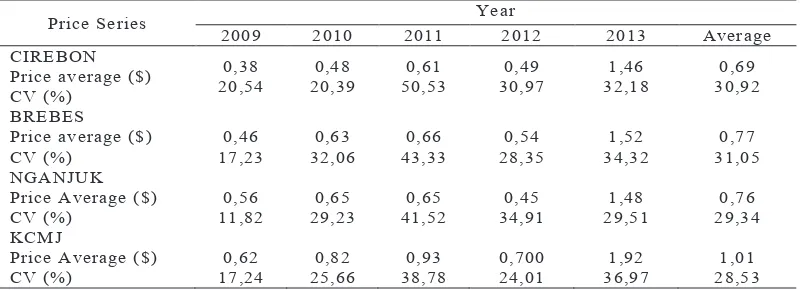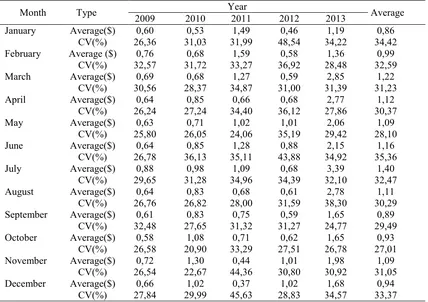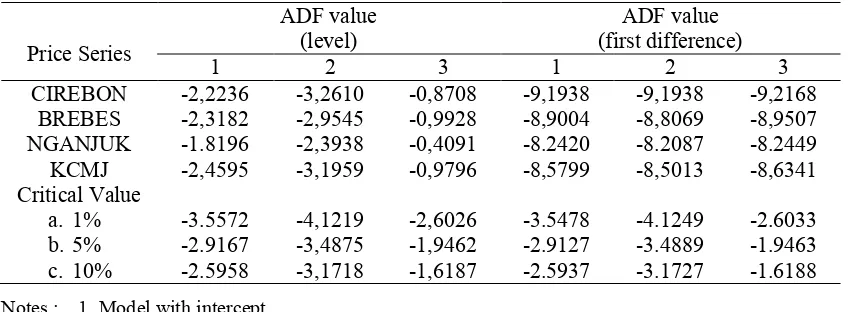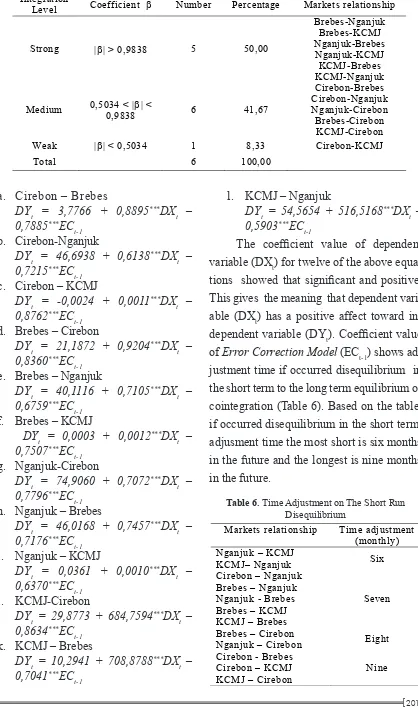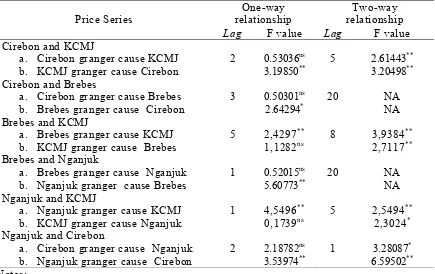Price Behavior and Market Integration of Shallot in Java
Indonesia
Susanawati (Corresponding author)
Faculty of Agriculture, Muhammadiyah University of Yogyakarta, Indonesia Jl. Lingkar Selatan Tamantirto Kasihan, Bantul, Yogyakarta, Indonesia Tel: +62-74-387646 Fax: +62-74-387646 E-mail [email protected]
Jamhari
Faculty of Agriculture, Gadjah Mada University of Yogyakarta, Indonesia Jl. Flora Bulaksumur Yogyakarta, Indonesia
Tel: +62-74-516656 Fax: +62-74-516656 E-mail: [email protected]
Masyhuri
Faculty of Agriculture, Gadjah Mada University of Yogyakarta, Indonesia Jl. Flora Bulaksumur Yogyakarta, Indonesia
Tel: +62-74-516656 Fax: +62-74-516656 E-mail: [email protected]
Dwidjono, H. D
Faculty of Agriculture, Gadjah Mada University of Yogyakarta, Indonesia Jl. Flora Bulaksumur Yogyakarta, Indonesia
Tel: +62-74-516656 Fax: +62-74-516656 E-mail: [email protected]
(Received: Sept 27, 2015. Reviewed: Oct 28, 2015; Accepted Nov 08, 2015)
Abstract: In Indonesia, shallot is a main seasonal vegetable crop that is always needed
by society. This condition leads to price luctuation in producers and consumers level. The
purpose of the paper is to examine price behavior, market integration, and leading market of shallot in Indonesia. This study uses producers and consumers monthly prices data at two producer’s markets (Cirebon, Brebes and Nganjuk district in java) and consumer’s market in Kramatjati Central Market, Jakarta ( KCMJ) during 2009-2013. Shallot price behavior
is analyzed by Coeficient of Variation (CV). Market integration is analyzed by Engle and
Granger model of co-integration. Granger causality test is used to identify the leading market. Result from the study show that monthly price behavior of shallot during 2009-2013 in producers and consumers market area have the same pattern. Shallot price in producers market is relatively more volatile than that of consumers market. Shallot price in Brebes relatively more volatile than that of in Cirebon and Nganjuk. As much as 50% shallot market integration in Indonesia is strong. In relationship of Nganjuk-KCMJ more integrated than of Brebes-KCMJ.In relationship of Cirebon-KCMJ also integrated despite weak. It takes six months to make adjustment if there is imbalance in the short-term relationship between Nganjuk-KCMJ and seven months for Brebes-KCMJ. The producer’s markets in Cirebon,
Brebes and Nganjuk inluence consumer’s market in KCMJ in determination shallot price.
Two-way relationship accur between Cirebon-KCMJ, Brebes-KCMJ and Nganjuk-KCMJ in
determination of shallot price, but in the difference lag. If price luctuation occurred in fact,
the government might not carry out intervention, because market mechanism was able to customized it.
▸ Baca selengkapnya: i……my wallet in this market two months ago
(2)1. Introduction
Shallot has many beneits among other things a source of carbohydrates, vita-mins A,B,and C (Anyanwu, 2003) dan could be consumed in fresh form.(Thompson and Kelly, 1987). The main beneit of shallot in everyday life is foodstuff, especially for la-voring dishes. Those consumption will con-tinue to increase in line with the increase in population and purchasing power. During the period 2011-2012, the increase in shallot production in irst quarter is 91,91 thou-sand tons (67.76 percent) and the second quarter is only 37,31 thousand tons (19.26 percent). Decrease in production occurred in thrid quarter by 13,46 thousand tons (4.28 percent) and forth quarter by 44,66 thou-sand tons (17.92 percent).
When categorized according to regions of Java and outside Java Island, shallot pro-duction in Indonesia is still concentrated in Java. Data of Central Statistics and Direc-torate of Horticulture (2012) during 2010-2012 showed that the average contribution of shallot production in Java towards national production is about 78% and the rest is from outside Java. Central Java contributes most of the moderation (40%) towards national production. Shallot production centres in Central Java is located in Brebes. The sec-ond largest of shallot production in Indone-sia is East Java with a contribution of around 27%. Shallot production centres in East Java were located in Nganjuk. The third largest of shallot production in Indonesia is West Java with a contribution of around 15%. Shallot production centres in West Java were located in Cirebon.
Demand of shallot is widely used for household consumption. This indicates that
the demand of shallot as the inal consump-tion is the largest. However, based on data of Ministry of Agriculture (2012), total mand of shallot from 2001 to 2005 has de-crease from 903.104 to 781.422 tons (86%). Demand of shallot began to increase again in 2006 to 2010. This is in line with the in-crease demand of shallot for non household. The amount of shallot consumption level at household is not really great, how-ever less availability of shallot commod-ity in the market and sharp price luctuation may cause disquiet in the society, so it is interesting to be discussed. At a time when shallot price is declined, the negative impact will be felt by farmers as the producers. But when price is rising, the consumers will feel aggrieved. At the same time a very striking price differences occur at producers and con-sumers level.
There are four techniques that were available to test market integration, that is correlation method, Ravallion procedure, co-integration approach, and parity bound model. Ravallion (1986) expanding tra-ditional static price correlation method to spatial price differensial model. The method used to co-integration test, among others Engle-Granger (1987) and Johansen test (1991). Parity bound model is developed by Sexton, Kling and Carman (1991) and Baulch (1997) explictly calculated linear the price of non-liniar relations in the spatial distributed market caused by transfer cost. Futhermore many researchers now focussed on modelling of inluence explycit treshold to test the law of one price.
In general, this this study intens to in-vestigate the market integration of shallot. In particular, it aims to analyse price behavior, market integration, and leading market of shallot in Indonesia. Result of this reserach can be used as refference for goverment in drawing up pricies related to development of shallot commodity.
2. Materials and Method
This reserach uses monthly price se-ries data of shallot on the producers level in Cirebon, Brebes and Nganjuk as weel as consumers market in KCMJ during 2009 to 2013. The data collected from Department of Agriculture and Horticulture and Fruit Market Unit of KCMJ. KCMJ used in this study because it is centre of Indonesia’s largest vegetables wholesale.
Price behavior of shallot was analyzed by using Coeficient of Variation (CV). Re-sults of CV was presented in table form to see price luctuation. The equation model of
CV as follows: CV =
x s
...(1) s =
2 1
1 1
1 n /
i
) x (xi
n
−
−
∑
=where :
s = standard deviation x= average price of shallot n = number of samples
Engle-Granger two-step co-integration
method is used to analyze market integra-tion of shallot market in Indonesia. The irst step is the unit root test that analyze with Augmented Dickey Fuller (ADF). The ADF method test whether the series or the order of integration of each variable is stasion-ary (Dickey and Fuller, 1979). The null hy-pothesis was used b= 0, price series (Pt) was non stationary. Testing criterion was done by comparing ADF statistics value with Mackinnon ctitical value (1990) in the signiicance level at 1%, 5%, and 10%. If ADF statistics value was bigger than criti-cal Mackinnon value, so the null hypothesis was rejected, it means price series was used stationary (Dickey and Fuller, 1979). The equation model of ADF test was:
D Yt = a + β Yt-1 + g2 DYt-2 + et...(2) where :
D Yt = Yt - Yt-1
Yt = shallot price at time t
a = vector of constant
β, g = parameter to be estimated e = pure white noise error term
us-ing ADF test as it has been done before. If not containing unit root problem, it means residue of regression equation was station-ary and could be said between variables in the regression was integrated or had a long-term relationship. The null hypothesis was used b= 0, series in the residual equation of co-integration et was non stationary. Testing of hypothesis by comparing ADF statistics value with Mackinnon critical value in the signiicance level at 1%, 5%, and 10%. If ADF value bigger than critical Mackinnon value, then the null hypothesis was rejected, it means that series in the equation residual of co-integration et was stationary. These results showed that between variables in the regression was integrated. The equation model was used as follows:
Y
t = b0 + b1Xt + et ...(3)
D e
t = a + β et-1 + g2 Det-2 + mt where :
Y
t = price in market y at time t X
t = price in market x at time t D e
t = et - et-1 e
t = residue at time t
β, g = parameter to be estimated m
t = error term
Co-integration showed existence of re-lationship or long-term equilibrium between variables in the regression. In the short term possibly occurred imbalance. It’s often oc-curred in the economics behavior, it means that what wanted by economic actors not necessarily same as what occurred in fact. The existence of difference what wanted by economic actors and what occurred then needed by existence of adjustment (Widar-jono, 2011).
The model that put adjustment to cor-rect short-term equilibrium to long-term
equilibrium was mentioned with Error Cor-rection Model (ECM) that was introduced by Sargan, developed by Hendry, and popu-larised by Engle and Granger (Nachrowi and Usman, 2006). The null hypothesis was used a2=0, residual from equilibrium error was non stationary. Testing of hypothesis was carried out by comparing t statistics val-ue with table valval-ue of t or could also by see-ing his probability. If t statistics value from residual of error correction variable bigger than table value of t means the null hypoth-esis was rejected or this coeficient was sta-tionary, so ECM model was used authentic and valid. The Equation model of ECM as follows:
DY
t = a0 + a1 DXt + a2 ECt-1 + et...(4)
ECt-1 = Yt-1 - b
0 - b1Xt-1...(6) where :
DYt = Yt-1 – Yt-2 ; DXt = Xt-1 – Xt-2
a0 = constant
a1 = short-term coeficient b1 = long-term coeficient a2 = parameter of adjustment ECt-1 = Error Correction
et = white noise error term
Granger causality test was used in this research to know response of price series in a market against the other market. This change response could walked in one-way from one market to the other market or two-way from two markets that were analyzed. Market said dominant or leading in the determination of price if price change in this market will be transmitted to the other markets. Equation model used in Granger causality test as fol-lows:
DP
1t = b01 + b02P1(t-1) + b03P2(t-1) + S¶
DP2t = b11 + b12P2(t-1) + b13P1(t-1) +
SFi(DP2(t-1)) +SliDP2(t-i) + et...(8)
where :
DP1t = P1t - P1(t-1); DP2t = P2t - P2(t-1)
b02, b03, d,¶ = parameter to be estimated from DP1t
b12, b13,F,l = parameter to be estimated from DP2t
et = error term
With assumption that P1 was price in consumer’s market and P2 in producer’s market at time t, then be based on the equa-tion above could be compiled by two null hypotheses can be composed to Granger cause relationship: (1) b03=d=0, price in pro-ducer's market not inluence towards price in consumer's market and (2) b03=a=0, price in consumer's market not inluence towards price in producer's market; The decision whether price in producer's market inlu-enced price in consumer's market and vice versa was used by F test. The testing hypoth-esis was used calculate F³ table value of F, then there is relationship where price in producer's market inluence towards price in consumer's market or price in consumer's market inluence towards price on the pro-ducer's market.
Results of Granger causality test could be used to detect relationship between vari-ables at least one-way relationship. If oc-curred two-way relationship, then to detect market leading was tested with t test. The null hypothesis was used b13£ b03, price on the producer’s market (P2) dominated price on the consumer’s market (P1). The testing criterion was used calculate t ³ table val-ue of t or the null hypothesis was rejected, it means price in consumer's market said
dominated price in producer's market. The equation model of F test was:
F (P, df) =
te)/df (RSScomple
e)/P RSScomplet d
(RSSreduce −
where:
df = degree of freedom
P = independent variables
RSS = Residual Sum of Square
3. Result and Discussion
3.1 Price Behavior
Average value of CV in producer’s mar-ket in Cirebon, Brebes and Nganjuk higher than that of consumer’s market in KCMJ, which means that shallot price in producer’s market in Cirebon, Brebes and Nganjuk rela-tive more luctuates compared to the price in consumer’s market in KCMJ. This results also give information that risk was occurred in producer’s market in Cirebon, Brebes and Nganjuk relatively higher than that of con-sumer’s market in KCMJ (Table 1).
Table 1 also shows that CV of shal-lot price in producer’s market in Brebes is highest, than followed by Cirebon and Nganjuk, which means that shallot price in producer’s market in Brebes relatively more luctuates than producer’s market in Cire-bon and Nganjuk. These results also give meaning that risk dealt with by the
farm-ers in Brebes was higher than the farmfarm-ers in Cirebon and Nganjuk. This condition may occur because shallot productions in Brebes was higher than Cirebon and Nganjuk.
Table 2 shows that average price of shallot each year was low in January, February, September, October, Decem-ber, and but high price in April until Au-gust as well as in November. The peak shallot price occurred in July each year. High a average CV each year occurred in January, February, March, June, July, November, and December. Average of CV highest each year occurred in June at 35,36 percent and lowered in October at 27,01 percent.
High value of CV indicates there is large price difference between pro-ducer’s market in Cirebon, Brebes and
Figure 1. Price Behavior of Shallot
Table 1. Price Series Behavior of Shallot
Source: KCMJ office, 2013
Price Series Year
2009 2010 2011 2012 2013 Average
CIREBON Price average ($) CV (%)
0,38 20,54
0,48 20,39
0,61 50,53
0,49 30,97
1,46 32,18
0,69 30,92
BREBES
Price average ($) CV (%)
0,46 17,23
0,63 32,06
0,66 43,33
0,54 28,35
1,52 34,32
0,77 31,05 NGANJUK
Price Average ($) CV (%)
0,56 11,82
0,65 29,23
0,65 41,52
0,45 34,91
1,48 29,51
0,76 29,34 KCMJ
Price Average ($) CV (%)
0,62 17,24
0,82 25,66
0,93 38,78
0,700 24,01
1,92 36,97
Nganjuk and consumer’s market in KCMJ. The large price difference could be caused by the existence of supply or production is increase or demand was downed in one place, so price became low, while elsewhere supply descended or demand is increased so price was ex-pensive.
3.2 Price Series Unit Root
Table 3 showed that ADF statistics value for four price series of shallot that used signiicant was good for equation con-tained intersept, intersept and trend, without intersept and trend. These results indicates that three price series variables contained unit root or not stationary in the level or I (0). In the irst difference level or I (1), ADF statistics value on four price series of shal-lot signiicant was good for equation
con-tained intercept, intercept and trend, without intercept, and trend. These results showed that four price series variables of shallot al-ready did not contain unit root or stationary in the irst difference level or I (1). Economi-cally, this result means the fourth price se-ries used had an average value wich does not vary from time to time and a limited variant.
3.3 Co-integration Between Price Series This test could be carried out because four price variables of shallot have been sta-tionary in the same order that is irst differ-ence or I (1). From twelve price series rela-tionship that used, all of ADF statistics value test for residual of regression equation big-ger than Mackinnon critical value in the irst difference level I (1) for signiicance level at 1%, 5%, and 10%, so able to be concluded that co-integration occur between shallot
Table 2. Spatial Price Behavior of Shallot
Source: KCMJ office, 2013
Month Type Year Average
2009 2010 2011 2012 2013 January Average($)
CV(%) February Average ($)
CV(%) March Average($)
CV(%) April Average($)
CV(%) August Average($)
CV(%) September Average($)
CV(%) October Average($)
CV(%) November Average($)
CV(%) December Average($)
markets. If increase or decrease of shallot price occured in market, it would integrated or when price movement on a market oc-curred, the price in another place also will change.
Based on average and standard de-viation value from coeficient (b) (Table 4) market integration level of shallot could be grouped into strong, medium, and weak, as being seen in Table 5. Based on twelve price series relationship was used, that 50% shal-lot market integration in Indonesia strong. These markets areNganjuk, Brebes-KCMJ, Nganjuk-Brebes, Nganjuk-Brebes-KCMJ, KCMJ-Brebes, and KCMJ-Nganjuk. In the relationship of Nganjuk-KCMJ more
inte-grated than of Brebes-KCMJ. Market in-tegration between Cirebon and KCMJ was weak, because only small portion of the shallot from Cirebon that was distributed to KCMJ.
The occurrence of co-integration or long-term equilibrium between price series was analyzed, enabled the occur-rence imbalance in the short term, so have to be carried out by error correc-tion equilibrium in the short term with ECM. The twelve equation of ECM be -low showed that Error Correction val-ue for all relationship between markets was negative and significant, so ECM model was used authentic and valid.
Table 3. ADF Statistics of Unit Root Test on Shallot Price Series
Price Series
ADF value (level)
ADF value (first difference)
1 2 3 1 2 3
CIREBON -2,2236 -3,2610 -0,8708 -9,1938 -9,1938 -9,2168 BREBES -2,3182 -2,9545 -0,9928 -8,9004 -8,8069 -8,9507 NGANJUK -1.8196 -2,3938 -0,4091 -8.2420 -8.2087 -8.2449 KCMJ -2,4595 -3,1959 -0,9796 -8,5799 -8,5013 -8,6341 Critical Value
a. 1% b. 5% c. 10%
-3.5572 -2.9167 -2.5958
-4,1219 -3,4875 -3,1718
-2,6026 -1,9462 -1,6187
-3.5478 -2.9127 -2.5937
-4.1249 -3.4889 -3.1727
-2.6033 -1.9463 -1.6188
Notes : 1. Model with intercept
2. Model with Intercept dan trend 3. Model without intercept dan trend
Source : KCMJ Office, 2013
Agriculture and Marine Officially in Cirebon, Brebes, and Nganjuk, 2013
Table 4. Co-integration Between price series (ADF t statistics)
Price Series
Cirebon Brebes Nganjuk KCMJ
ADF
value
ADF
value
ADF
value
ADF value
Cirebon -0,8192* ** -3,9038 -0,7686* ** -4,4011 -0,5034* -2,7047
Brebes -0,7637* ** -3,8329 -1,6194* ** -7,2286 -1,5646* ** -6,7797
Nganjuk -0,7144* ** -4,1031 -1,6656* ** -7,3068 -1,5833* ** -7,2894
KCMJ -0,5423* * -2,9664 -1,5403* ** 6,7611 -1,5526* ** 7,2870
Notes :
a. Cirebon – Brebes variable (DXt) for twelve of the above equa-tions showed that signiicant and positive. This gives the meaning that dependent vari-able (DXt) has a positive affect toward in-dependent variable (DYt). Coeficient value of Error Correction Model (ECt-1) shows ad-justment time if occurred disequilibrium in the short term to the long term equilibrium or cointegration (Table 6). Based on the table, if occurred disequilibrium in the short term, adjusment time the most short is six months in the future and the longest is nine months in the future.
Table 6. Time Adjustment on The Short Run Disequilibrium
Table 5. Shallot Price Series Relationship Base on Integration Level
Integration
Level Coefficient Number Percentage Markets relationship
Strong > 0,9838 5 50,00
Markets relationship Time adjustment
(monthly) Nganjuk – KCMJ
KCMJ– Nganjuk Six
Cirebon – Nganjuk Brebes – Nganjuk Nganjuk - Brebes Brebes – KCMJ KCMJ – Brebes
Seven
Brebes – Cirebon
Nganjuk – Cirebon Eight
Cirebon - Brebes Cirebon – KCMJ
3.4 Granger Causality Analysis of Shallot
Price Series
Table 7 showed at the consumer’s mar-ket in KCMJ inluenced producer’s marmar-ket in Cirebon, but producer’s market in Cirebon not inluenced consumer’s market in KCMJ after two months in the future. Two-way relationship occurred between producer’s market in Cirebon and consumer’s market in KCMJ after ive months in the future. The producer’s markets in Brebes and Nganjuk affected consumer’s market in KCMJ in de-termination of shallot price, but producer’s market in Cirebon not affected consumer’s market in KCMJ.
Two-way relationship in determina-tion of shallot price occurred between Ci-rebon-KCMJ and Nganjuk-KCMJ after ive months in the future, whereas Brebes-KCMJ after eight months in the future. Two-way relationship not occurred between
Cirebon-Brebes and Cirebon-Brebes-Nganjuk in the determi-nation of shallot price.
4. Conclusion
Price behavior of shallot in producer’s market in Cirebon, Brebes and Nganjuk as well as consumer’s market in KCMJ dur-ing 2009 to 2013 showed the same move-ment. Shallot price in consumer’s market in KCMJ relatively more stable compared with producer’s market in Brebes and Ngan-juk. Shallot price in the producer’s market in Brebes relatively more luctuates com-pared with producer’s market in Cirebon and Nganjuk. Shallot price high luctuation be-tween markets each year occurred in Janu-ary, FebruJanu-ary, March, June, July, Novem-ber, DecemNovem-ber, and low luctuation in April, May, October.
Strong integration level occurred in Brebes-Nganjuk; Brebes-KCMJ;
Nganjuk-Table 7. Price Series Causality
Price Series
One-way relationship
Two-way relationship
Lag F value Lag F value Cirebon and KCMJ
a. Cirebon granger cause KCMJ b. KCMJ granger cause Cirebon
2 0.53036ns 3.19850**
5 2.61443** 3.20498** Cirebon and Brebes
a. Cirebon granger cause Brebes b. Brebes granger cause Cirebon
3 0.50301ns 2.64294*
20 NA NA Brebes and KCMJ
a. Brebes granger cause KCMJ b. KCMJ granger cause Brebes
5 2,4297** 1,1282ns
8 3,9384** 2,7117** Brebes and Nganjuk
a. Brebes granger cause Nganjuk b. Nganjuk granger cause Brebes
1 0.52015ns 5.60773**
20 NA NA Nganjuk and KCMJ
a. Nganjuk granger cause KCMJ b. KCMJ granger cause Nganjuk
1 4,5496** 0,1739ns
5 2,5494** 2,3024* Nganjuk and Cirebon
a. Cirebon granger cause Nganjuk b. Nganjuk granger cause Cirebon
2 2.18782ns 3.53974**
1 3.28087* 6.59502** Notes:
**
, *,and ns indicates granger causality at 5% level, 10%, and not significant respectively NA : Not Available
Brebes; Nganjuk-KCM; and KCMJ-Ngan-juk relationship. In relationship of NganKCMJ-Ngan-juk- Nganjuk-KCMJ more integrated than of Brebes-KC-MJ, although have the same strong integra-tion. In relationship of Cirebon-KCMJ was integrated despite weak. If occurring imbal-ance in the short-term relationship between Nganjuk-KCMJ, adjustment time needed to long-term equlibrium was six monthly. Time needed for disequilibrium adjustment in the short-term relationship between Brebes-KCMJ was seven monthly. Needed nine monthly if occurring disequilibrium in the short-term relationship between Cirebon-KCMJ.
The producer’s markets in Brebes and Nganjuk affected consumer’s market in KCMJ in determination of shallot price or occurred one-way relationship, but pro-ducer’s market in Cirebon not affected con-sumer’s market in KCMJ. Two-way rela-tionship occurred between Cirebon-KCMJ, Brebes-KCMJ and Nganjuk-KCMJ despite in difference lag. In these relationship was not seen by existence of market leading for determination of shallot price. Two-way re-lationship not occurred between Cirebon-Brebes and Cirebon-Brebes-Nganjuk in determina-tion of shallot price, but shallot price in the producer’s market in Brebes inluenced producer’s market in Cirebon. Shallot price in the producer’s market in Nganjuk inlu-enced producer’s market in Brebes.
Based on CV value, the role of related agency must be increased especially in cul-tivation technology during off season and post-harvest. Optimalization of the role of cold storage and Indonesia’s Shallot As-sociation in Brebes to reduce price luctua-tion and supporting of shallot marketing are
needed. The existence of market integra-tion between producer’s market in Cirebon, Brebes and Nganjuk as well as consumer’s market in KCMJ showed that if price luctu-ation occurred in fact the government might not carry out intervention, because market mechanism was able to customized it.
Acknowledgment
Authors thank to Dr. Witono Adiyoga of BALITSA Lembang Bandung; Professor Siti Subandiyah, and Professor Masyhuri of Agriculture Faculty, Gadjah Mada Univer-sity for opportunity to join ACIAR (Austra-lian Centre for International Agriculture Re-search) project during 2012 to 2015. Authors also thank to ACIAR for fund supporting to the research.
References
Anyanwu, B.O. (2003). Agricultural Science For School and College. Africa First Publisher, Onistha, Nigeria.
Dickey, D.A. and W.A. Fuller. (1979). Dis-tribution of The Estimators for Autore-gressive Time Series with a Unit Root. Journal of American Statistical Asso-ciation 74(366): 427-432.
Engle, R. dan C.W.J. Granger. (1987). Co-integration and Error Correction : Rep-resentation, Estimation, and Testing. Econometrica 55: 251-276.
Goodwin, B.K. and T.C. Schroeder. (1991). Co-integration Test and Spatial Price Linkages in Regional Cattle Market. American Journal of Agricultural Eco-nomics, 73 : 1264 – 1273.
Models. Econometrica 59 : 1551-1580. MacKinnon,J.G. (1990). Critical Values for
Co-integration Tests. Mimeograph. Canada: Departement of Economics, Queen’s University.
McNew, K. (1996). Spatial Market Integra-tion : DefoniIntegra-tion, Theory, and Evi-dence. Agricultural and Resource Eco-nomics Review 25 : 1-11.
Muwanga, G.S. and D.L. Snyder. (1997). Market Integration and Law of One Price : Case Study of Selected Feeder Cattle Markets. Economic Research Institute Study Paper #97-11. Utah State University.
Nachrowi, N.D., and Usman, H. (2006). Econometrica for Economic and Fi-nance Analysis. UI. Jakarta.
Palaskas, Theodosios, B. and Barbara Har-ris-White. (1993). Testing Market In-tegration: New Approach with Case
Material from the West Bengal Food Economy. Journal of Development Studies, 30(1) : 1-57.
Ravallion M. (1986). Testing Market Inte-gration. American Journal of Agricul-tural Economics 68 (1): 102-109.
Sexton, R.J., C.L. Kling, and H.F. Carman. (1991). Market Integration, Eficiency of Arbitrage and Imperfect Competition: methodology and Appli-cation to U.S. Celery. American Journal of Agricultural Economics 17(2) : 568-580.
Thompson, H.C. and Kelly, C.N. (1987). Vegetable Crops. Fifth edition. Mc -Graw Hills Book Coompany, New York, Toronto London.
Widarjono, A. (2011). Econometrica Theo-ry and Aplication: For Economic and Business. Economic Faculty. Univer-sity of Islam Indonesia. Yogyakarta.
